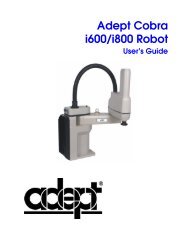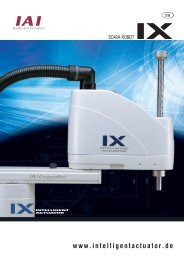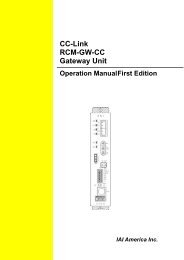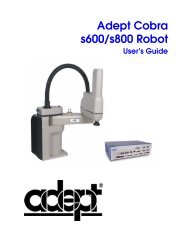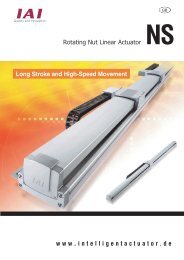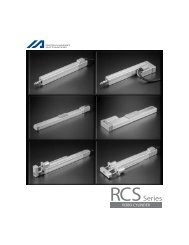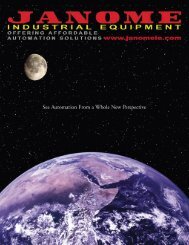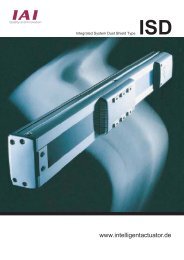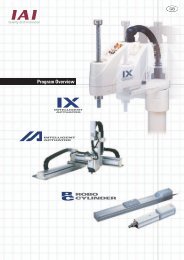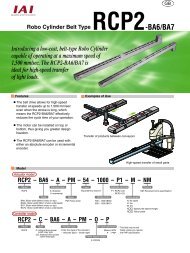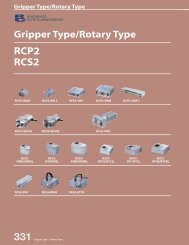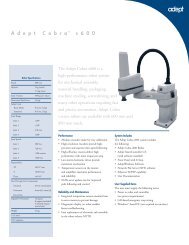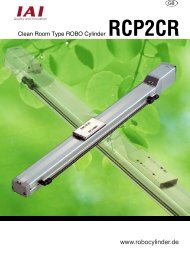Download Adept Cobra PLC600 User's Guide - pulsar.com.tr
Download Adept Cobra PLC600 User's Guide - pulsar.com.tr
Download Adept Cobra PLC600 User's Guide - pulsar.com.tr
You also want an ePaper? Increase the reach of your titles
YUMPU automatically turns print PDFs into web optimized ePapers that Google loves.
PLC Software Overview<br />
Bit 1 determines whether the <s<strong>tr</strong>ong>com</s<strong>tr</strong>ong>ponent values of the location that is referenced by the<br />
Location Number register (N240:6 or <s<strong>tr</strong>ong>Adept</s<strong>tr</strong>ong>_Location_Number) are Cartesian or joint<br />
coordinates.<br />
Bit 7 selects the acceleration profile that will be used to start and end the motion. The<br />
<strong>tr</strong>apezoidal profile (bit 7 off) consists of a constant acceleration to the steady-state <strong>tr</strong>ansit<br />
speed, followed by a constant deceleration to the motion endpoint. The S-curve profile (bit<br />
7 on) consists of a soft <strong>tr</strong>ansition between: stopped to acceleration ramp; acceleration<br />
ramp to steady-state <strong>tr</strong>ansit speed; steady-state <strong>tr</strong>ansit speed to deceleration ramp; and<br />
deceleration to motion end point (see Figure 6-5).<br />
Figure 6-5. S-Curve versus Trapezoid Acceleration Profile<br />
Bit 8 determines the effect of the approach-height value (N240:7 or<br />
<s<strong>tr</strong>ong>Adept</s<strong>tr</strong>ong>_Approach_Height).<br />
• If this bit is off, the next motion will approach the location with this Z offset from<br />
the defined location.<br />
• If this bit is on, the next motion moves to the specified destination location using<br />
this absolute Z value, based on the World Coordinate System. That is, the Z<br />
<s<strong>tr</strong>ong>com</s<strong>tr</strong>ong>ponent of the location definition will be ignored.<br />
NOTE: This overrides the setting of bit 0.<br />
See page 138 for more details on approach and depart; see page 142 for more details on<br />
the World Coordinate System.<br />
Bit 9 determines if the motion will be joint-interpolated or s<strong>tr</strong>aight-line. If s<strong>tr</strong>aight-line<br />
motion is chosen, it is not possible to change the arm configuration during the motion (see<br />
bits 13 to 15).<br />
When bit 10 is off, continuous-path motion is disabled, and the robot will null at the<br />
destination before the next motion is planned. This could increase cycle time. Setting this<br />
bit will allow the PLC Server to blend motions (i.e., round corners between motion<br />
segments), assuming that the next motion is <s<strong>tr</strong>ong>com</s<strong>tr</strong>ong>manded in sufficient time before the<br />
current motion <s<strong>tr</strong>ong>com</s<strong>tr</strong>ong>pletes.<br />
<s<strong>tr</strong>ong>Adept</s<strong>tr</strong>ong> <s<strong>tr</strong>ong>Cobra</s<strong>tr</strong>ong> <s<strong>tr</strong>ong>PLC600</s<strong>tr</strong>ong>/PLC800 Robot User’s <s<strong>tr</strong>ong>Guide</s<strong>tr</strong>ong>, Rev B 89



